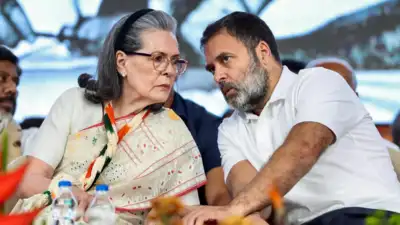Monday , 29 September 2025
Recent Posts
Politics
 Newsium DeskApril 16, 20252 Mins read89 Views
Newsium DeskApril 16, 20252 Mins read89 Views
ED Charges Sonia and Rahul Gandhi – Key Highlights from Chargesheet

ED investigation National Herald

National Herald Case: ED Chargesheet Against Sonia and Rahul Gandhi
Introduction
- Overview of the National Herald Case: Introduce the case involving prominent Congress leaders Sonia and Rahul Gandhi, highlighting its significance in Indian politics.
- Importance of the ED Chargesheet: Explain why the Enforcement Directorate’s (ED) chargesheet is a pivotal development in this ongoing investigation.
1. Background of the National Herald Case
- Origins of the National Herald Newspaper: Discuss the founding of the National Herald in 1937 by Jawaharlal Nehru and its role in India’s independence movement.
- Transition to Associated Journals Limited (AJL): Explain how the newspaper was managed by AJL and its subsequent financial challenges.
- Formation of Young Indian Ltd. (YIL): Detail the creation of YIL in 2010, its acquisition of AJL’s debts, and the involvement of Sonia and Rahul Gandhi as majority shareholders.
2. Initiation of Legal Proceedings
- Subramanian Swamy’s Complaint: Describe the 2012 complaint filed by BJP leader Subramanian Swamy alleging financial improprieties in the acquisition of AJL by YIL.
- Court’s Cognizance and ED’s Involvement: Outline how the courts took cognizance of the complaint in 2014, leading to the ED initiating a money laundering investigation in 2021.
3. Details of the ED Chargesheet
- Accusations Against Sonia and Rahul Gandhi: Summarize the ED’s allegations, including the formation of a shell company to illegally acquire property worth $300 million associated with the National Herald newspaper.
- Legal Provisions Invoked: Explain the sections of the Prevention of Money Laundering Act (PMLA) cited in the chargesheet, such as Sections 3, 44, 45, and 70, and the potential penalties under Section 4.
- Other Individuals Named: Mention other Congress party members and associates included in the chargesheet.
4. Financial Transactions Under Scrutiny
- Acquisition of AJL’s Assets: Detail how YIL acquired AJL’s properties, valued at approximately Rs 2,000 crore, for a nominal amount of Rs 50 lakh.
- Alleged Bogus Transactions: Discuss the ED’s findings of fabricated donations, advance rents, and fake advertisements used to generate proceeds of crime.
- Total Proceeds of Crime Identified: Highlight the ED’s identification of proceeds of crime amounting to Rs 988 crore.
5. Asset Attachments and Seizures
- Properties Attached by the ED: List the immovable assets in Delhi, Mumbai, and Lucknow attached by the ED, including the National Herald’s office premises.
- Legal Proceedings for Possession: Explain the ED’s actions to take possession of these assets and the legal notices issued to property registrars.
6. Political Reactions and Implications
- Congress Party’s Response: Describe the Congress party’s stance, labeling the investigation as politically motivated and an act of vendetta by the ruling government.
- Statements from Party Leaders: Include reactions from key Congress figures, such as Jairam Ramesh, emphasizing their commitment to fight the charges.
- Impact on Indian Politics: Analyze how the case affects the political landscape, especially in the context of upcoming elections.
7. Legal Proceedings and Court Developments
- Court Hearings and Bail: Provide updates on court hearings, including the bail granted to Sonia and Rahul Gandhi in December 2015.
- Supreme Court and High Court Rulings: Discuss how higher courts have upheld the legal proceedings, allowing the investigation to proceed.
- Future Legal Steps: Outline the expected legal trajectory, including potential trials and appeals.
8. Broader Implications and Public Perception
- Media Coverage and Public Opinion: Examine how the case has been portrayed in the media and its influence on public perception of political accountability.
- Implications for Anti-Corruption Efforts: Discuss the case’s significance in the broader context of India’s efforts to combat corruption.
- Potential Reforms and Policy Changes: Speculate on how this case might lead to changes in laws governing political funding and corporate governance.
Recent Posts
Categories
- Actor4
- Actress7
- Bank4
- Biography2
- Bollywood4
- Business10
- Company9
- cricket4
- Economy23
- Education6
- Entertainment47
- External Affairs Defence Security1
- Finance1
- Football1
- Health1
- Hollywood2
- Home1
- India70
- india9
- Industry6
- Latest News53
- lifestyle1
- maharashtra1
- market4
- Politicians13
- Politics29
- Press Release282
- Social8
- Sports28
- Stock Marekt18
- Technology24
- Tollywood2
- World40
- world17
Related Articles
IndiaLatest NewsPolitics
“Rajnath Singh Says Modi to Stay BJP’s PM Candidate for Future”
Strong Statement on India’s Political Future Defence Minister Rajnath Singh has sent...
ByNewsium DeskSeptember 24, 2025
Politics
Rahul Gandhi Accuses CEC of Shielding Democracy Destroyers
Rahul Gandhi Accuses CEC of Shielding Those Who ‘Destroyed Democracy’ Congress leader...
ByNewsium DeskSeptember 18, 2025
Politics
Rohan Jaitley Responds to Rahul Gandhi’s Remark on Father
Rohan Jaitley Responds to Rahul Gandhi’s Remark on Father Arun Jaitley: A...
ByNewsium DeskAugust 2, 2025
Politics
Trump Repeated India-Pak Ceasefire Claim: Ramesh
Introduction In a striking political critique, senior Congress leader Jairam Ramesh recently...
ByNewsium DeskJuly 15, 2025













Leave a comment